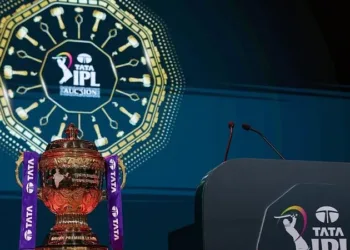Mother Nature played the ultimate umpire at Brisbane’s Gabba on December 3, 2024, as persistent rain and lightning forced the abandonment of the series decider after just 4.5 overs. With India racing to 52/0, the washout confirmed India’s fourth consecutive bilateral T20 series victory over Australia, cementing their dominance in the shortest format Down Under.
Table of Contents
India vs Australia Match Summary: Rain Steals the Show
| Category | Details |
|---|---|
| Venue | The Gabba, Brisbane |
| Date | December 3, 2024 |
| Match Result | Abandoned (Rain) |
| Series Outcome | India won 2-1 |
| India’s Score | 52/0 in 4.5 overs |
| Opening Stand | Abhishek Sharma & Shubman Gill |
| Toss Winner | Australia (elected to bowl) |
| Man of the Series | Abhishek Sharma |
| Historic Milestone | Abhishek Sharma – Fastest to 1000 T20I runs |
Sharma’s Record-Breaking Feat Before Rain Arrived
Before the heavens opened, Abhishek Sharma etched his name into cricketing history by becoming the fastest batter to reach 1,000 T20I runs, showcasing explosive form that defined India’s tour. The left-handed dynamo, partnering with Shubman Gill, capitalized on two dropped catches to propel India beyond 50 in less than five overs.

Australia’s fielding lapses—with Matthew Short and Marcus Stoinis grassing straightforward chances—proved costly as the Indian openers seized momentum during the powerplay. The Gabba’s pace-friendly surface facilitated boundary-hitting, with India’s aggressive approach threatening to post another challenging total.
For cricket enthusiasts following India’s triumphant T20 campaign, this series showcased the team’s depth and tactical flexibility under captain Suryakumar Yadav’s leadership.
When Lightning Struck and Dreams Washed Away
Lightning warnings forced the initial stoppage, followed by persistent rain that ultimately led umpires to call off the match as the forecast remained unfavorable. Despite optimism about a potential restart, Brisbane’s notorious unpredictable weather patterns sealed the match’s fate.
The Gabba’s excellent drainage system offered brief hope, but continuous downpours made resumption impossible. With no minimum overs bowled to constitute a result, the match was officially abandoned, handing India the series victory based on their superior 2-1 record after four completed games.
India’s Dominant Series Performance
This victory marks India’s fourth consecutive win over Australia in T20 bilaterals—both home and away—highlighting the team’s supremacy in this format. The series featured thrilling encounters, with India’s spin attack proving particularly lethal on Australian surfaces.
Key performers throughout the series included Varun Chakaravarthy’s mystery spin, Arshdeep Singh’s death bowling prowess, and consistent batting contributions from Abhishek Sharma, Suryakumar Yadav, and Rinku Singh. The team’s ability to adapt to conditions and execute under pressure demonstrated championship mentality.
The second match was completely washed out, while Australia salvaged pride with victory in the opening encounter. However, India’s clinical performances in games three and four—particularly the fourth T20I where they defended 163/7 with exceptional spin bowling—established their dominance.
Man of the Series: Abhishek Sharma’s Breakout Tour
The explosive opening batter Abhishek Sharma was named Man of the Series for the five-match T20I series against Australia, capping a remarkable tour that announced his arrival on the international stage. His fearless batting approach, combining power with timing, troubled Australian bowlers throughout.
Sharma’s record of reaching 1000 T20I runs in the fewest balls showcases his strike rate and aggressive intent—qualities perfectly suited for modern T20 cricket. His ability to dominate powerplay overs provides India crucial momentum, setting platforms for middle-order consolidation.
Similar to how legendary Indian cricketers built their legacies, Sharma’s performances suggest a bright future as one of India’s premier T20 specialists capable of match-winning impacts.

What This Series Victory Means
Beyond immediate bragging rights, this series triumph reinforces India’s status as T20 cricket’s most formidable team. With the T20 World Cup approaching, the exposure of playing in Australian conditions against quality opposition provides invaluable preparation.
Young talents like Abhishek Sharma, Rinku Singh, and Nitish Kumar Reddy gained crucial international experience, while established stars like Jasprit Bumrah and Suryakumar Yadav continued delivering when it mattered most. The squad depth displayed throughout ensures India possesses multiple options for various match situations.
The victory also demonstrates India’s ability to perform without several first-choice players rested for workload management ahead of the Test series. This bench strength positions India favorably for sustained success across formats.
Team Changes and Tactical Decisions
India made strategic rotation throughout the series, managing player workloads while maintaining competitive edge. Rinku Singh’s inclusion over Tilak Varma for the final match exemplified this approach, though the abandonment prevented him from showcasing his finishing abilities.
Australia maintained consistency in selection but struggled to find winning combinations against India’s varied attack. Mitchell Marsh’s decision to bowl first at The Gabba aligned with historical statistics favoring teams defending at this venue, though weather prevented any conclusions.
Border-Gavaskar Trophy Awaits
The Indians will now shift their attention towards important assignments including a home series against South Africa featuring Tests, ODIs, and T20Is starting November 14, before eventually returning to Australia for the prestigious Border-Gavaskar Trophy Test series.
The T20 series served as perfect preparation, acclimatizing players to Australian conditions, crowd hostility, and the intensity of Indo-Australian cricket rivalry. Players like Jasprit Bumrah, who featured selectively in T20s, will become central figures in the Test battles ahead.
India aims to defend the Border-Gavaskar Trophy on Australian soil—a feat achieved in their last two tours. The confidence gained from T20 success, combined with experienced Test specialists, positions India strongly for the grueling five-Test series.
Historical Context of India’s Australian Dominance
India’s recent success in Australia represents a dramatic shift from historical trends where touring the country was considered cricket’s toughest challenge. From being whitewashed regularly to winning consecutive Test series and dominating white-ball formats, India’s transformation reflects improved fitness, mental toughness, and tactical sophistication.
The T20 bilateral victories extend this dominance into the shortest format, with Indian players increasingly comfortable in Australian conditions. The combination of pace-bowling depth, spin variations, and explosive batting creates a well-rounded unit capable of succeeding anywhere.
For comprehensive match statistics and official coverage, visit NDTV Sports’ detailed scorecard.
The series may have ended anticlimactically due to weather, but India’s comprehensive victory across completed matches leaves no doubt about their superiority in T20 cricket currently.
Frequently Asked Questions
Why was the 5th T20I abandoned and how did India win the series?
The final T20I at The Gabba was abandoned after just 4.5 overs due to persistent rain and unfavorable weather forecasts that made resuming play impossible. India had reached 52/0 when lightning warnings initially stopped play, followed by continuous downpours. Since no minimum of five overs per side could be completed to constitute a result, the match was called off. This abandonment confirmed India’s series victory 2-1, as they had won the third and fourth T20Is after Australia won the opener, with the second match also being washed out. According to series rules, when a match cannot produce a result, the team leading in completed games wins the series. India’s dominant performances in games three and four at Hobart and Brisbane respectively established their superiority regardless of the final match outcome.
What made Abhishek Sharma’s performance worthy of the Man of the Series award?
Abhishek Sharma earned the Man of the Series award through consistently explosive performances that changed game momentum in India’s favor. His crowning achievement came in the abandoned fifth T20I when he became the fastest batter ever to reach 1,000 runs in T20 Internationals based on balls faced, surpassing all previous record holders. Throughout the series, Sharma’s fearless approach in powerplay overs set platforms for Indian victories, with his ability to attack from ball one putting immediate pressure on Australian bowlers. His strike rate exceeded 180 during the series, demonstrating the aggressive intent that defines modern T20 cricket. Beyond raw numbers, Sharma’s impact came from providing flying starts that allowed middle-order batters to play with freedom, contributing significantly to India’s successful run chases and defending totals by building early momentum.








